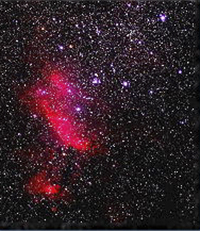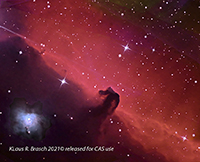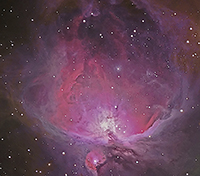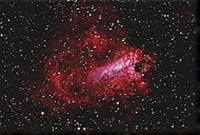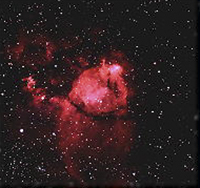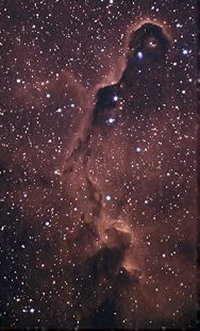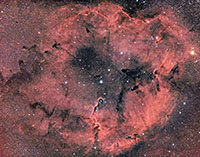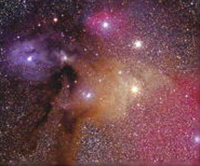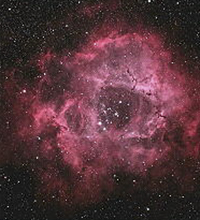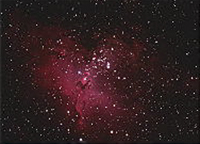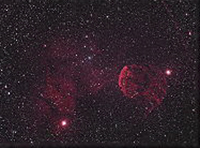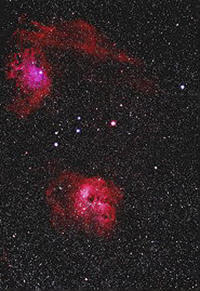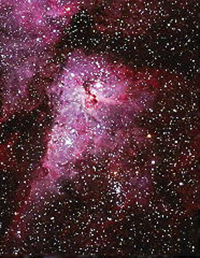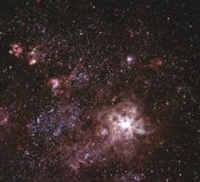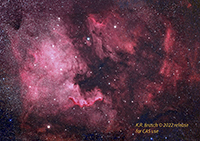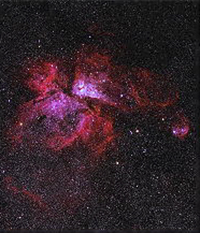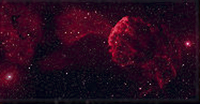Nebulae 1 of 7
Gallery 1 || Gallery 2 || Gallery 3 || Gallery 4 || Gallery 5 || Gallery 6 || Gallery 7|
IC 4628 |
For more information see Wikipedia, the free encyclopedia, at http://en.wikipedia.org/wiki/Prawn_Nebula on March 1, 2014 |
|
Horse Head (Barnard 33) |
As one of the most iconic dark nebulae in Orion, the Horse Head (Barnard 33) can be glimpsed with a medium size telescope and appropriate filters and makes a stunning image photographically. This is a composite of several frames taken recently from my observatory in Flagstaff with a 12.5-inch Plane Wave and a Canon 6D Mark III shooting at ISO 6200 and an IDAS LPS-V4 filter. Cumulative exposure was 25 minutes. |
|
Veil Nebula West |
It took me quite a while, but I finally managed to generate this hybrid image of the western portion of the Veil Nebula. It consists of a mosaic of several C-14 f/7 images combined with a stack of images taken with the TMB-130 refractor, all using an IDAS LPS V4 filter and the Canon 6D. The cumulative exposure was 32 minutes at ISO 6400. For more information see Wikipedia, the free encyclopedia, at http://en.wikipedia.org/wiki/Veil_Nebula |
|
Orion Nebula |
|
|
Messier 17 |
Information on Messier 17 is available at http://en.wikipedia.org/wiki/Messier_17 |
|
IC 1795 |
IC 1795, also cataloged as NGC 896 is a star forming region in the northern constellation Cassiopeia. Not far on the sky from the famous Double Star Cluster in Perseus, IC 1795 is itself located next to IC 1805, the Heart Nebula, as part of a complex of star forming regions that lie at the edge of a large molecular cloud. Located just over 6,000 light-years away, the larger star forming complex sprawls along the Perseus spiral arm of our Milky Way Galaxy. |
|
IC 1396 |
Information on IC1396 is available at http://en.wikipedia.org/wiki/IC1396 |
|
Elephant's Trunk |
The photo was taken with my AP-155 at f/5.2, and IDAS LPS-V4 filter at ISO 6400. The final image is a mosaic of several frames taken in 2018 with two modified Canon DSLRs, a model 6D and a newer model 6D Mark II. Combined exposures are about 1 hour, stacked and processed in Photoshop CS-6. |
|
Rho Ophiuchus |
|
|
Rosette Nebula |
Information on the Rosette Nebula is available at http://en.wikipedia.org/wiki/Rosette_Nebula |
|
Messier 16 |
|
|
IC 443 & IC 444 |
|
|
Flaming Star Nebula |
|
|
Keyhole Nebula |
|
|
Tarantula Nebula |
|
|
North American Nebula |
As one of the most iconic dark nebulae in Orion, the Horse Head (Barnard 33) can be glimpsed Who doesn’t love the North America Nebula (NGC 7000)? On really dark, transparent nights you can actually spot it by naked eye close to Deneb in Cygnus. What we tend to forget is that this enormous start forming complex, about 1,700 LY from us, also includes the Pelican Nebula (IC 5070) and additional extended nebulosity and dark dust lanes. This image, taken with a TMB-92 f/5.5 refractor and modified Canon 6D and IDAS LPS-V4 filter, covers about 90% of the brightest portions of this complex. This mosaic was composed from 8 x 2–3-minute frames shot at ISO 3200. Images were stacked in Affinity Photo and then processed in Photoshop CS6. Klaus Brasch |
|
Carinae Nebula |
|
|
Jellyfish Nebula |
December 15, 2015A mosaic of about a half dozen exposures taken with my TMB-130 apo with the Canon 6Dat ISO 3200-6400 and IDAS LPS v3 filter. Cumulative exposure about 30 minutes. Below is the wiki description" IC 443 (also known as the Jellyfish Nebula and Sharpless 248 (Sh2-248)) is a Galactic supernova remnant (SNR) in the constellation Gemini. On the plan of the sky, it is located near the star Eta Geminorum. Its distance is roughly 5,000 light years from Earth. IC 443 may be the remains of a supernova that occurred 3,000 - 30,000 years ago. The same supernova event likely created the neutron star CXOU J061705.3+222127,the collapsed remnant of the stellar core. IC 443 is one of the best-studied cases of supernova remnants interacting with surrounding molecular clouds..
Kluas Brasch |
|
|
|
Nebulae (from the Latin: "clouds") are interstellar clouds of dust, hydrogen, helium and other ionized gases. All are located within our own Milky Way galaxy. However, before the true nature of galaxies was established by Vesto Slipher, Edwin Hubble and other astronomers during the early part of the 20th century, all diffuse astronomical objects were called nebulae. That was because at that time, it was widely thought the Milky Way was the entire universe.
Nebulae come in various sizes and shapes. Among the largest and most prominent are star-forming regions like the Orion Nebula (M-42), the Lagoon Nebula (M-8) and the Eagle Nebula (M-16); all favorites in small telescopes. Such objects usually appear pink or orange-red in long exposure photographs because they contain ionized hydrogen which emits light of those wavelengths (H-α). The Eagle Nebula or M-16 is depicted in one of the Hubble Space Telescope’s (HST) most famous images, the "Pillars of Creation". In such regions the accumulation of gas, dust, and other materials "clump" together into larger masses, which gravitationally attract further matter, and eventually condense into proto-stellar disks and then stars. The materials circling such proto-stars are believed to form planets and other planetary system objects.
In addition to such emission nebulae, our galaxy is also populated with dark nebulae, which are actually interstellar dust blocking visible light waves. The famed Horse Head nebula is one such example. Other colors, including blue and turquoise hues, are also caused by interstellar dust particles which preferentially scatter blue light. The blue colorations associated with parts of the Orion Nebula and Triffid Nebula (M-20) are examples of that.
Other favorite types of objects to observe with amateur telescopes are the so-called planetary nebulae. The Dumbbell (M-27), Ring (M-57) and Helix nebulae are popular examples. The term planetary comes from the fact that many of these objects appeared planet-like to early astronomers when seen in small telescopes. In actual fact they are the remnants of stars in the latter stages of their evolution when they eject masses of gas into an expanding shell. Stars which are much larger than our sun or unusual binary stars, will die in more dramatic fashion by undergoing a catastrophic explosion called a supernova. The remnants of such stars are subsequently scattered throughout the galaxy. The Veil Nebula and IC 443 and 444 are prominent examples of that.
A supernova explosion was recently observed in the nearby-galaxy M-82.
Klaus Brasch
Outreach || Flagstaff || Photos || Articles || Observing Sites || Weather
Coordinated Universal Time || National Weather Service
info@coconinoastro.org


